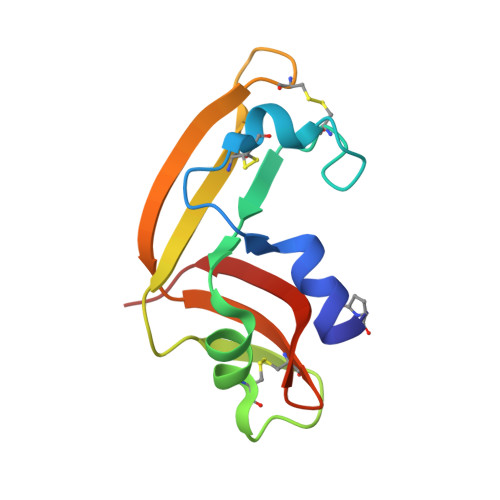Impact of the C-terminal disulfide bond on the folding and stability of onconase.
Schulenburg, C., Weininger, U., Neumann, P., Meiselbach, H., Stubbs, M.T., Sticht, H., Balbach, J., Ulbrich-Hofmann, R., Arnold, U.(2010) Chembiochem 11: 978-986
- PubMed: 20349493
- DOI: https://doi.org/10.1002/cbic.200900773
- Primary Citation of Related Structures:
2KB6, 3FD7 - PubMed Abstract:
The two homologous proteins ribonuclease A and onconase fold through conserved initial contacts but differ significantly in their thermodynamic stability. A disulfide bond is located in the folding initiation site of onconase (the C-terminal part of the protein molecule) that is missing in ribonuclease A, whereas the other three disulfide bonds of onconase are conserved in ribonuclease A. Consequently, the deletion of this C-terminal disulfide bond (C87-C104) allows the impact of the contacts in this region on the folding of onconase to be studied. We found the C87A/C104A-onconase variant to be less active and less stable than the wild-type protein, whereas the tertiary structure, which was determined by both X-ray crystallography and NMR spectroscopy, was only marginally affected. The folding kinetics of the variant, however, were found to be changed considerably in comparison to wild-type onconase. Proton exchange experiments in combination with two-dimensional NMR spectroscopy revealed differences in the native-state dynamics of the two proteins in the folding initiation site, which are held responsible for the changed folding mechanism. Likewise, the molecular dynamics simulation of the unfolding reaction indicated disparities for both proteins. Our results show that the high stability of onconase is based on the efficient stabilization of the folding initiation site by the C-terminal disulfide bond. The formation of the on-pathway intermediate, which is detectable during the folding of the wild-type protein and promotes the fast and efficient refolding reaction, requires the presence of this covalent bond.
Organizational Affiliation:
Institute of Biochemistry and Biotechnology, Martin-Luther University Halle-Wittenberg, Kurt-Mothes-Strasse 3, 06120 Halle, Germany.















